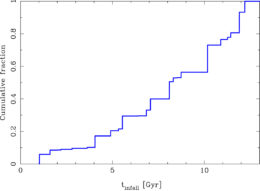The mysterious object Segue 1 has intrigued astronomers since it was first discovered in 2007. A new study has now measured the first proper motions for this tiny neighboring galaxy, providing clues as to how it came to be in orbit around the Milky Way.
An Unusual Neighbor

NGC 147 is another example of a dwarf spheroidal galaxy in the Local Group. [Ole Nielsen]
Segue 1, a Milky Way satellite just ~75,000 light-years away (that’s half the distance to the Large Magellanic Cloud!), was the first of these ultra-faint dwarf spheroidal galaxies to be discovered — and scientists have been debating its nature ever since.
It’s not just Segue 1’s nature that’s debated, however; we also want to understand where this tiny galaxy came from, and how it ended up in orbit around the Milky Way. To address these questions, a team of scientists led by Tobias Fritz (University of Virginia; IAC and University of La Laguna, Spain) have made the first proper-motion observations of this unusual object.

Color-magnitude diagram of stars in Segue 1; spectroscopically identified members are shown in blue and non-members in red. [Fritz et al. 2018]
Pinning Down Proper Motion
Fritz and collaborators measured Segue 1’s proper motion using data from the Sloan Digital Sky Survey and the Large Binocular Camera over a baseline of 10 years. Their measurements put Segue 1 on an orbit that circles the Milky Way once every ~600 million years — which suggests it’s quite tightly bound to our galaxy.
The authors point out that the orbit inferred for Segue 1 support its classification as a galaxy rather than a disrupted star cluster: Segue 1 doesn’t pass close enough to the Milky Way to have been tidally disrupted. But how did this tiny galaxy arrive in orbit around the Milky Way in the first place?
Simulated Origins
There are two main options: Segue 1 was either accreted on its own, or it was the satellite of a larger, classical satellite that was accreted by the Milky Way. The parameters of its orbit rule out the possibility that it once orbited one of the known massive classical satellites of the Milky Way, but it’s still possible that it could have initially orbited a long-since destroyed massive satellite.

Infall times for Segue 1 analogs in the cosmological simulations. The median first infall time is about 8 billion years ago. [Adapted from Fritz et al. 2018]
Fritz and collaborators find a 25% likelihood that Segue 1 first arrived in orbit around a long-since-destroyed satellite, with both it and its host accreted by the Milky Way ~12 billion years ago. Even more likely, at 75% probability, Segue 1 accreted on its own perhaps 8 billion years ago.
More detailed future measurements will likely give us an even clearer picture of Segue 1’s orbit and potential origins. In the meantime, there’s a whole wealth of other ultra-faint dwarfs like Segue 1 to explore!
Citation
T. K. Fritz et al 2018 ApJ 860 164. doi:10.3847/1538-4357/aac516

1 Comment
Pingback: Seeing Double: Binary stars in dwarf galaxies | astrobites